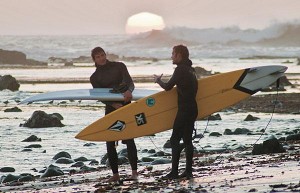
In one of the first efforts ever to quantify the worth of a wave, a group of academics, surfers and environmentalists have put a price on Mavericks. It’s an exercise some environmental economists and ocean advocates call “surfonomics” – a calculation of the intrinsic dollar value of Mother Nature’s unique features.
The study, conducted earlier this year on the Mavericks parking lot and the beach wrapping around Pillar Point, rendered a report that puts the value of the famed wave break at $23.9 million a year.
Save the Waves Coalition, a nonprofit group devoted to preserving surf spots around the world, produced the report. Mavericks Surf Ventures, the company that hosts the Mavericks Surf Contest, and contest sponsor Jim Beam helped fund the study.
Save the Waves conducted a similar study two years ago in Mundaka, Spain, where a river mouth generates a world-famous surf break on the country’s northern coast. But the study focused on the economic impact to the locale after a sandbar break crippled the renowned break. It was a post-mortem assessment. With the Mavericks report, released at the end of October, surfers and ocean advocates put a price tag on the annual net worth of the wave.
“There’s not a market value for that but it clearly has value. … The idea is, if you’re going to spend $10 on gas and four hours of time to go visit someplace like Mavericks, well, it’s at least as valuable as that money and that wear and tear on your car or you wouldn’t go,” said Chad Nelsen, environmental director for SurfRider Foundation. Nelsen occupies a seat on the coalition’s board of directors and is writing his dissertation at University of California, Los Angeles, on the economic value of surfing.
“It more accurately gets to the total value (of Mavericks), as opposed to spending associated with it,” says Dean LaTourrette, executive director for Save the Waves.
LaTourette says surfers are merely a “subset” of frequenters to the beach. The worth is contingent largely on the “visit-and-watch component,” he says.
A pair of economists at the University of Hawaii extrapolated the hard numbers from a six-month test period running January to June and responses from 200 Mavericks beachgoers. According to the report, people pay more than 421,000 annual visits to Mavericks – an average of more than 1,150 per day. Mavericks is valued at $56.70 per visit, meaning that’s how much money people are willing to pay for the experience. And those figures exclude the estimated tens of thousands of surf-watchers who roll in for the one-day Mavericks Surf Contest.
Makena Coffman is an economist and regional planning professor at University of Hawaii who is unaffiliated with Save the Waves and Mavericks Surf Ventures. She helped craft the methodology of the study and co-authored the report.
To establish a solid grasp of the fluid surf break, Coffman and a colleague at the university extrapolated findings from a litany of queries to visitors using a “travel cost” model. Driving distance, number of trips per year, why people visit and how long they spend at Mavericks are among the determinants shaping the conclusions. More information about survey data should be available when the final report is released later this month, Coffman said.
When questioned about the specific figures, Coffman held firm on each finding save for the annual population estimate, which she calls a “first pass” at understanding visits to the area.
“We took specific measures to underestimate that,” she said.
Nelsen said the coalition “could have done a more robust study,” given that conclusions stem from a six-month period that missed the heart of surf season on a famously mild year for big waves. Still, he says such studies are an important means of understanding the economic weight of natural beauty people might take for granted.
“Often the perception is zero (value),” Nelsen said, “and when management decisions are being made at the Coastal Commission and they’re trying to balance a decision on development, developers always have hard numbers for anticipated revenues and job growth. This will give us at least one measure of looking at the values that exist today for these spots.”

No comments:
Post a Comment